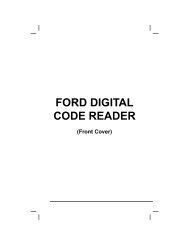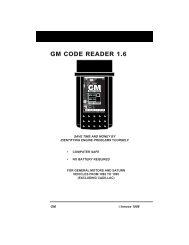You also want an ePaper? Increase the reach of your titles
YUMPU automatically turns print PDFs into web optimized ePapers that Google loves.
Onboard Diagnostics<br />
OBD2 MONITORS<br />
� If the conditions that caused the MIL to light are no longer present<br />
for the next three trips in a row, the computer automatically turns the<br />
MIL “Off” if no other emissions-related faults are present. However,<br />
the DTCs remain in the computer’s memory as a history code for 40<br />
warm-up cycles (80 warm-up cycles for fuel and misfire faults). The<br />
DTCs are automatically erased if the fault that caused them to be<br />
set is not detected again during that period.<br />
� Misfire and fuel system faults require three trips with “similar<br />
conditions” before the MIL is turned “Off.” These are trips where the<br />
engine load, RPM and temperature are similar to the conditions<br />
present when the fault was first found.<br />
After the MIL has been turned off, DTCs and Freeze Frame<br />
data stay in the computer’s memory.<br />
� Erasing the DTCs from the computer’s memory can also turn off the<br />
MIL. See ERASING OBD2 DIAGNOSTIC TROUBLE CODES (DTCs)<br />
on page 48, before erasing codes from the computer’s memory. If a<br />
Diagnostic Tool or Scan Tool is used to erase the codes, Freeze<br />
Frame data will also be erased.<br />
OBD2 MONITORS<br />
To ensure the correct operation of the various emissions-related<br />
components and systems, a diagnostic program was developed and<br />
installed in the vehicle’s on-board computer. The program has several<br />
procedures and diagnostic strategies. Each procedure or diagnostic<br />
strategy is made to monitor the operation of, and run diagnostic tests on,<br />
a specific emissions-related component or system. These tests ensure<br />
the system is running correctly and is within the manufacturer’s<br />
specifications. On OBD2 systems, these procedures and diagnostic<br />
strategies are called “Monitors.”<br />
Currently, fifteen Monitors are supported by OBD2 systems. Additional<br />
monitors may be added as a result of Government regulations as the<br />
OBD2 system grows and matures. Not all vehicles support all fifteen<br />
Monitors. Additionally, some Monitors are supported by “spark ignition”<br />
vehicles only, while others are supported by “compression ignition”<br />
vehicles only.<br />
Monitor operation is either “Continuous” or “Non-Continuous,”<br />
depending on the specific monitor.<br />
Continuous Monitors<br />
Three of these Monitors are designed to constantly monitor their<br />
associated components and/or systems for proper operation.<br />
Continuous Monitors run constantly when the engine is running. The<br />
Continuous Monitors are:<br />
Comprehensive Component Monitor (CCM)<br />
Misfire Monitor<br />
Fuel System Monitor<br />
OBD2&1 19




